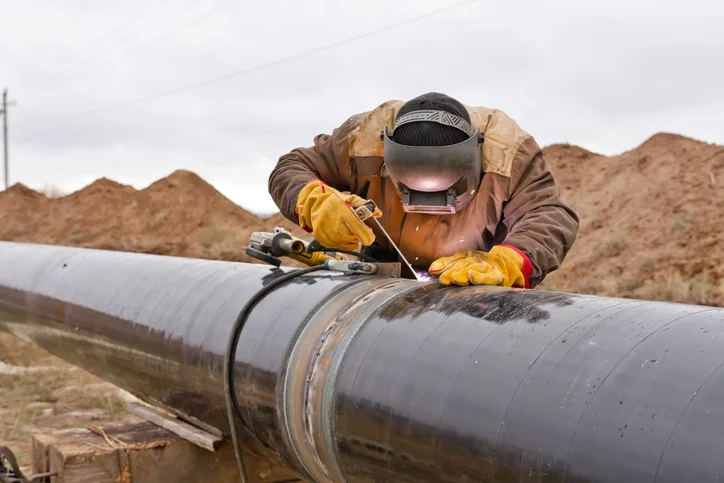Accuracy Issues: Relied On Pipeline Welding Inspection Providers for Critical Projects
Accuracy Issues: Relied On Pipeline Welding Inspection Providers for Critical Projects
Blog Article
Comprehensive Summary of Pipe Welding Evaluation Treatments
Pipe welding examination procedures play an essential role in assuring that welded connections fulfill strict industry criteria and requirements. From precise pre-welding inspections to thorough post-weld analyses, a well-defined examination procedure is vital for maintaining the architectural strength of pipelines.
Pre-welding Examination Preparations
Prior to beginning the welding process, thorough pre-welding examination prep work are vital to guarantee the integrity and top quality of the weld joint. These preparations involve a thorough assessment of the materials to be bonded, the welding devices, and the work setting. By carrying out extensive pre-welding inspection prep work, prospective issues can be recognized and solved early on, leading to premium and dependable weld joints.
Welding Procedure Certification
Comprehensive pre-welding examination preparations lay the structure for the vital procedure of Welding Procedure Credentials, making certain the honesty and top quality of the weld joint. Welding Treatment Certification (WPQ) is an essential action in the welding process that entails screening and certifying welding treatments to guarantee they satisfy specific requirements and requirements. The WPQ process commonly includes welding treatment requirements development, welding treatment credentials testing, and paperwork of the outcomes.
During welding procedure spec growth, important information such as the welding procedure, welding products, joint design, and welding specifications are specified to develop a comprehensive procedure. Consequently, welding treatment credentials screening is conducted to validate the suggested treatment's honesty. This screening often involves welding examination discount coupons that go through numerous mechanical and non-destructive examinations to evaluate the weld's quality and adherence to the specified standards.
In-process Weld Evaluation
During the welding process, in-process weld assessment plays a critical role in ensuring the quality and integrity of the weld joint - Pipeline Welding Inspection. This sort of evaluation includes keeping track of the welding specifications, evaluating the weld bead formation, and discovering any type of potential problems or suspensions as they occur. By conducting in-process weld inspections, welding operators can promptly resolve any kind of concerns that may develop, consequently making sure and stopping additional problems that the final weld fulfills the called for requirements
Typical approaches used for in-process weld assessment consist of visual evaluation, fluid penetrant screening, magnetic fragment testing, ultrasonic testing, and radiographic screening. Aesthetic assessment is commonly the very first step at the same time, allowing assessors to visually analyze the weld for surface area irregularities such as splits, porosity, or incomplete fusion. Advanced methods like ultrasonic screening and radiographic testing give in-depth insights right into the inner structure of the weld, ensuring that there are no surprise problems that can jeopardize the weld joint's stamina and integrity. Generally, in-process weld inspection is crucial for maintaining the quality and integrity of welded pipelines.
Non-destructive Testing (NDT)
Non-destructive Screening (NDT) is a crucial technique used in pipe welding inspection to evaluate the honesty of weld joints without creating damages to the welded structure. By using different NDT strategies, assessors can review the quality of welds and identify any type of problems or stoppages that might compromise the structural soundness of the pipe. Typical NDT approaches made use of in pipe welding examination consist of Radiographic Screening (RT), Ultrasonic Screening (UT), Magnetic Fragment Testing (MPT), Fluid Penetrant Screening (LPT), and Visual Screening (VT)
RT entails making use of X-rays or gamma rays to generate pictures of the inner framework of the weld, permitting assessors to identify issues such as porosity, splits, or insufficient blend. UT utilizes high-frequency acoustic waves to find problems underneath the surface of the weld, providing comprehensive information about the dimension and area of flaws. MPT and LPT are utilized right here to determine surface-breaking problems by applying penetrant fluids or magnetic particles to the weld location. Furthermore, VT includes visual inspection of welds to recognize any type of visible imperfections.
Post-weld Assessment and Documentation


Paperwork of post-weld examination searchings for is crucial for preserving quality control documents and ensuring conformity with industry criteria and guidelines. Comprehensive records should consist of information regarding the examination techniques made use of, the location and nature of any type of issues discovered, and any kind of corrective actions taken - Pipeline Welding Inspection. Correct documentation not only works as a record of the weld's high quality yet also aids in future upkeep and examination processes
Final Thought

In conclusion, pipeline welding inspection procedures play an essential function in guaranteeing the high quality and stability of welds. Generally, adherence to appropriate examination methods is vital to the success of pipe welding jobs.
From careful pre-welding assessments to detailed post-weld evaluations, a well-defined evaluation process is necessary for keeping the architectural sturdiness of pipelines. By performing in-process weld inspections, welding drivers can promptly address any type of problems that may arise, therefore guaranteeing and preventing more flaws that the final weld meets the called for specs.
Common approaches utilized for in-process weld inspection consist of visual evaluation, liquid penetrant screening, magnetic particle testing, ultrasonic screening, and click for more info radiographic testing.Non-destructive Testing (NDT) is an essential approach utilized in pipeline welding assessment to evaluate the honesty of weld joints without triggering damage to the welded framework. Post-weld assessment involves different methods to examine the welds for problems, consisting of visual assessment, dye penetrant screening, magnetic particle testing, ultrasonic screening, and radiographic testing.
Report this page